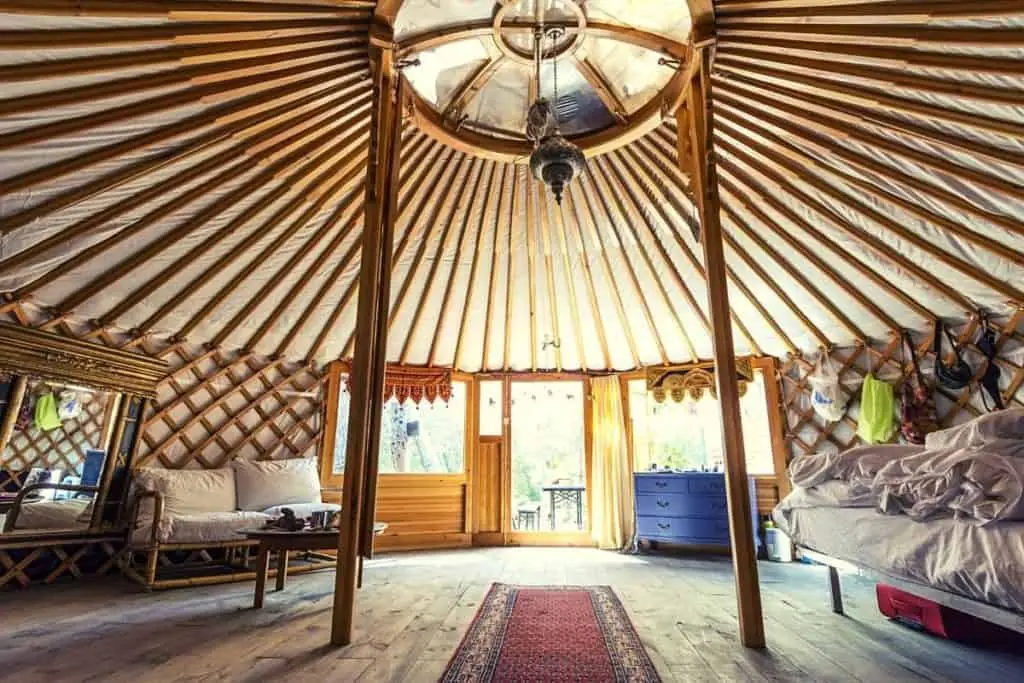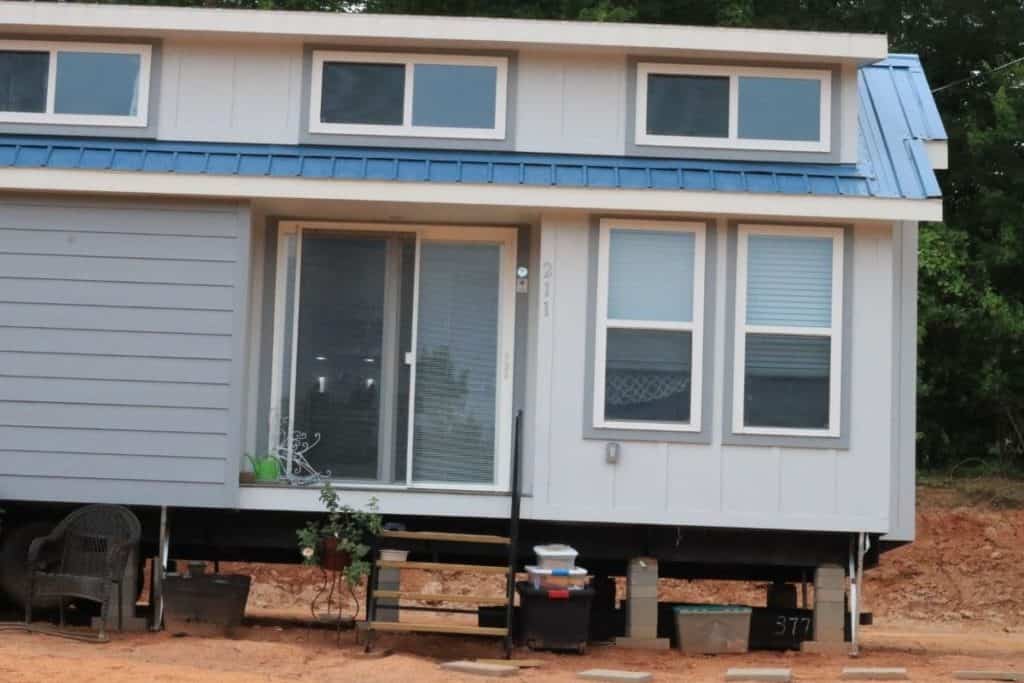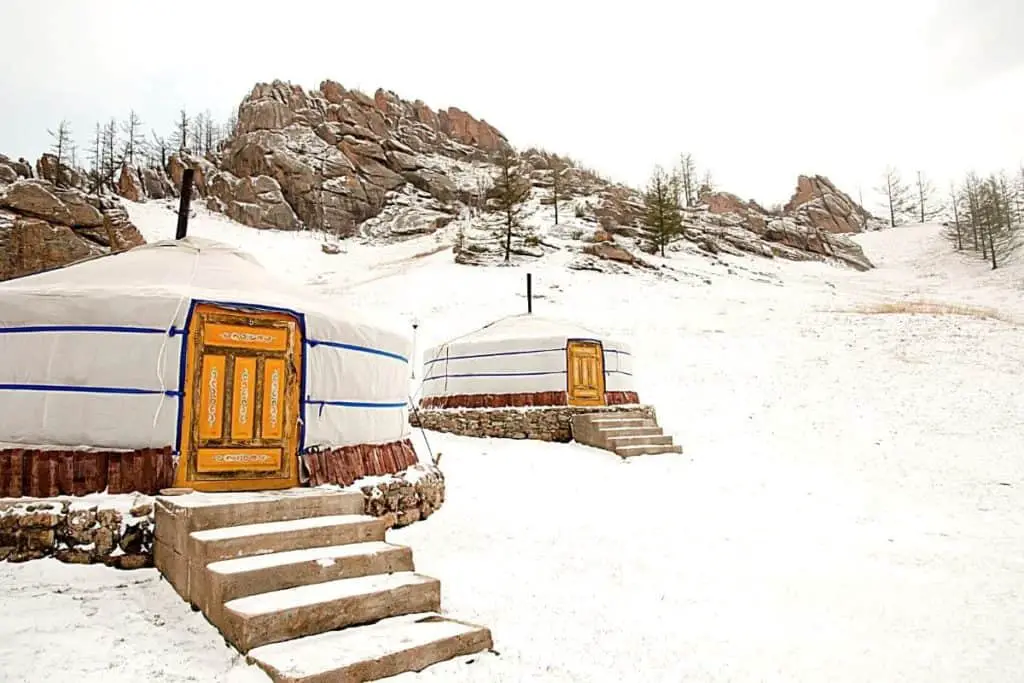Ever since the pandemic began, and people were confined to their houses—a lot of them began thinking about alternatives. Around the globe, however, people have always been dwelling in several unconventional places and houses like RVs, tents, and cob houses. This led me down a fresh rabbit hole when I heard about yurts in particular.
What exactly is the difference between a yurt and a tiny house?
Modern yurts are round, tent-like structures made from architectural fabric intended to be semi-permanent. Tiny homes are under 400 square feet and can have a traditional foundation or be built on wheels specifically for portability.
What does this matter? Will it work for you? Let’s dig in!
How does a Yurt Compare to a Tiny House?
First, let’s chat about what each of them actually are because tiny house terms get thrown around – not necessarily uniformly!
Yurts
Historically, traditional yurts were circular portable dwellings that were essentially a type of ancient form of a modern day tent. However, they were primarily from felt and skins according to the all-knowing Wikipedia.
These were traditionally used by the nomadic people of Central Asian countries, like Turkey, Mongolia, etc. who never stayed anywhere for too long.
Today, yurts are growing popular among the West for people who want to live unconventional, nomadic, and minimalist lifestyles, away from the hustling and bustling of everyday in large and small cities.
Currently, there are semi-permanent yurt options made from engineered fabrics and more permanent ones that resemble a yurt style even if made with more traditional building methods.
Regardless of the type of yurt you are thinking of, the advancement in yurt technology essentially means that they can weather storms better. Pun always intended here.

Tiny Houses
Tiny houses are yet another alternative to regular housing for people who want to live a minimalist or at least a more mindful lifestyle. The actual definition of a tiny house is a dwelling that is 100-400 square feet.
However, most consider a tiny home to be a dwelling on wheels that isn’t quite an RV or a home built with traditional materials that is within the range of the 400 square foot definition.
Tiny houses present a wonderful opportunity to people who still do not want to go completely off the grid but still live in a place that is modern and unconventional. Read more about the pros and cons of tiny houses here.
How does a yurt compare to a tiny house?
By the basic definition of the square footage rule, a yurt IS a tiny house. However, they do have differences based on calling a tiny house a dwelling on wheels or a smaller home with a traditional building materials vs modern yurts.
After all, both tiny houses and yurts can conceivable have a lot of overlap in lifestyle, environmental benefits, cost, and more
However, even within those assumptions, there are some differences to help make a better, more informed choice on what fits for your lifestyle.
Are yurts cheaper than tiny houses?
Both tiny homes and yurts benefit from being smaller than a traditional house, so that alone makes them cheaper regardless simply by needing less material.
Windows, roofing, and every other elements add up with the extra square feet, particularly with permanent structures!
Basic, medium-sized yurts can cost $12,000 to $20,000 to erect depending on the materials used. There are fabrics, insulation and other options that make a yurt more durable and comfortable that will put you on the higher end of this range.
On the flip side, Rocket Homes shared that the average cost of a tiny house with about the same square feet of space can cost $30,000 to $50,000, again, depending on the materials used.
While both options are more cost effective than a standard house, yurts are cheaper than tiny homes. Yurts are intended to be semi-permanent and the use of fabric over traditional building materials makes them cheaper.
Pacific Yurts have been manufacturing yurts for sale since the 1970s, and their pricing is in the $8-$16k range and can be shipped if you’d like a place to start.
Which is Easier to Build?
There are similarities since all dwellings need basic foundations, framing, roofing, and everything else that makes a home work for shelter.
In general, yurts are not as labor intensive to build compared to a tiny house based on the materials required and permanent building methods versus those of a more temporary nature.
After all, yurts are made from fabric, and fabric is simply not designed to last the same amount of time that traditional building materials and building codes will.
A traditional home will likely take weeks or months to build, but a yurt will take weeks to construct as they are not built with permanence in mind.

Is a Tiny House or Yurt More Durable?
A tiny house will last as long as a traditional house if maintained well, but you would be surprised by how long a yurt can last!
Tiny homes may need exterior elements replaced such as the roof and siding after 15-25 years with a lot of variation based on the material type and maintenance.
Yurts are similar. The fabric of a yurt can get damaged and require replacement, but the fabric is expected to last 15-20 years. If the roof and walls keep the framing and foundation protected, in theory, they can last as long as a a traditional home.
Tiny homes on a standard foundation are more durable than yurts as they are designed to be permanent and can withstand the elements such as storms better than a fabric yurt tent.
Also, tiny homes on wheels have additional maintenance. Travel trailer set ups undergo a lot of wear and tear on the road. Tires, bearings, rust. The actual dwelling compartment will last longer than the trailer, but all of the trailer elements can have an extended life by staying on top of maintenance.
Research more about how safe tiny homes are (or are not) by reading this article.
What About Portability? Yurt or Tiny House for the Win?
Tiny homes on wheels are more portable than yurts as yurts are semi-permanent versus built on a trailer for ease of portability.
Yurts, in that sense, is for someone who wants to remain in a single place for a longer period of time. Yurts provide more floor space than a tiny house on wheels and are non-movable lodgings.
Last in this category is the tiny house with a traditional foundation. Tiny houses like this can be moved, but it is more like literally moving a house even if the dimensions make it possible to fit the requirements for easier road transport.

Which is More Comfortable in More Extreme Weather?
A lot of people doubt if yurts can endure the harshness of cold weathers given that they are literally wrapped in fabric. However, yurts can endure cold weather, and there are many insulation options depending on what you’re willing to spend essentially.
Remember that yurts thrived and were traditionally used in Central Asian countries where it snows in winter. If the roof and other materials of the yurt are maintained well, they can endure any weather that is thrown at them.
Tiny homes are more traditional homes, so you have likely experienced that. Air conditioning and more is usually built in to help here with a basic level of insulation a standard versus an ‘extra’.
In general, tiny homes will regulate temperature better than a yurt.
Summary
If you’re considering adopting one of these homes in your future, it’s a highly personal decision depending on what you hope to accomplish and live with. Regardless, both options give you the potential for financial freedom and a chance at a more minimalistic, more mindful lifestyle. You can find my growing list of reasons to live in a tiny house here.
- Tiny homes on wheels offer the best in portability.
- Tiny homes with a more standard foundation excels in providing comfort and safety from weather extremes, as well as, being the most durable.
- Yurts are the cheapest option, and they are definitely the easiest structure to build.
